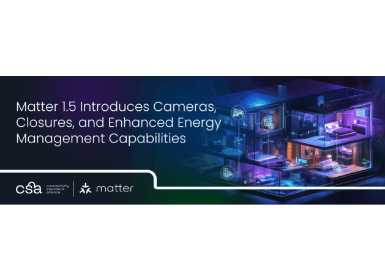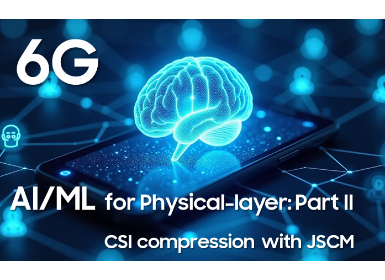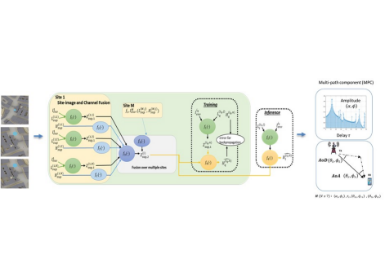Communications
CSA Releases Matter 1.3 Specification and SDK for Smart Home IoT Standardization
Background
Matter was first launched on October 2022, backed by major companies in the residential IoT space: including Samsung Electronics, Amazon, Apple, Google, and others.
The Matter program encompasses a full protocol specification, built on IPv6, which supports device discovery, provisioning, and control, all over secured interfaces. Additionally, there is an open-source SDK that supports all of the functions necessary to certify a Matter device, and a certification program with an automated test harness and test cases.
In this post, we explore more on what is new in the latest Matter 1.3 release that was launched May 8th, 2024.

Matter release history
Since its launch, Matter 1.0, and subsequent 1.1 and 1.2 specifications, have been implemented, certified, and commercialized in over a thousand devices produced by CSA member companies. The major ecosystems (including Samsung SmartThings) all provide the ability to commission and control Matter devices via their apps and controllers (e.g., IoT Hub device, TV, etc.), all of which are also subject to certification and other testing to ensure interoperability.

Figure 1. List of major devices per Matter Release version
Examples of Matter enabled products in the marketplace include the Essentials lighting range from Nanoleaf, Philips Hue lighting, smart plugs and sensors from Eve, bridges from Aqara, and many more.
What is now possible with Matter 1.3?
Deeper dive into Scenes
Consider the scenario where you want multiple different devices in your home to go to certain settings at the same time. For example, at night time you may want lights to dim or turn off, fans to turn on, shades to close. Or you may want a "home entertainment" mode where the lights go to certain colours and settings, the thermostat is adjusted, and the TV is set to a specific volume.
This is all possible with the inclusion of Scenes in Matter 1.3. This allows an application such as SmartThings to create Scenes by provisioning devices with the settings that are desired for the specific Scene. A Scene could be targeted at a single device, or a group of devices. The support for Scenes is mandated by Matter for certain device types, these being: Lighting and Smart Plugs; they are optional for all other device types.
Thus, once the Scene has been setup, it can be activated directly or via an automation, depending on your application.

Figure 2. Example of Scene operation
Deeper dive into Water Control
Coming home to a flooded house, or going to a weekend cottage and finding water damage, both are scenarios that IoT devices can help alleviate, and both now supported in Matter 1.3.
A home owner, with Matter 1.3 device types, will now be able to install Matter controllable valves in their water supply system to key devices such as a water heater. This, coupled with a Matter water leak detector, enables a controller application such as SmartThings to receive an event or notification that water leak has been detected, and then to shut off the associated control valve, thus minimizing or preventing potential water damage.

Figure 3. Water valve
Deeper dive into Energy Reporting & EVSE (Electric Vehicle Supply Equipment)
How much energy or power is being consumed by your connected devices? Equally, how much energy is being consumed by your devices that are plugged into your Smart Plugs? Given increased concern and awareness of energy costs, both are pieces of information that provide value to a consumer or to an energy-aware application such as SmartThings.
Matter 1.3 provides the building blocks that allow a device vendor, should they choose to provide to a controller application information related to the energy and/or power consumption of the device.
The energy reported can be periodic (period determined by the device) or cumulative (over the lifetime of the device). Matter also supports the reporting of energy generated, for device types that are so capable (e.g. batteries, solar cells in the future, etc.). Units of mWh are used for the reporting of energy (either consumed or generated).
Recently, it is easy to spot an electric vehicle (EV) on the road. This advent of EV adoption and growth among the general public naturally permeates to many home owners. Thus, EVSE (Electric Vehicle Supply Equipment) became a compelling energy management use case for Matter 1.3 release since intelligent energy and cost-efficient operation of EVSEs will be a necessity for EV owners.

Figure 4. EVSE Energy Management Feature for EV at Home
Matter 1.3 introduces an EVSE cluster and device type to realize the intelligent EV charging operation based on user usage profile, utility tariff schedule, and renewal energy availability at home. By utilizing typical user daily usage range and EV charging status information, EVSE can make sure that the next morning's travel is ready to go. For the EV charging schedule, EVSE can determine the most economical time and period to charge the EV based on the home owner’s utility price plan. In addition, if a home owner has a solar panel generating excess power (or tapped into some battery power source), an EVSE can reroute that extra energy to charge the EV to further enhance energy efficiency.
EVSE can not only manage charging EV, but they also enable EVs to discharge as a battery power source to the home in case of power outage emergency if EVSE supports power line communication. This bi-directional capability solidifies EVSE as a must-have energy management feature for EV owned home owners. Also, EVSE monitors and controls various safety features and mechanism to ensure EV protection and prevent any charging incident (e.g., Max charging current/power, connection status during charging, etc.). Overall, EVSE is the most prominent energy management feature of the Matter 1.3 release.
Other Matter 1.3 Device Types
Matter 1.3 also sees a broadening of the device types that are covered by the specification. The new device types are summarized in the following list:
• Additional White Goods (Appliances): Cooktop, Laundry Dryer, Microwave, Oven
• Enhancements to the existing TV/Media related device types.
For each of the new device types Matter supports the ability to: control the device, query the status of the device, receive notifications or alarms on the change of status of the device or any of its attributes as appropriate.
Conclusion and Next Steps
Matter 1.3 sees the addition of interesting capabilities such as Scenes, which can enhance the consumers experience with their IoT devices via controller applications such as SmartThings. Matter 1.3 also defines new device types, extending the set of devices for which Matter enables interoperability across IoT ecosystems.
Moving forwards, Matter will continue to provide enhancements to the current feature set, improving the user's ownership experience, and broader support for additional value-added services such as Cameras, Streaming Audio, Device Energy Management, and so forth. As for all of the releases to date, expect to see such enhancements on a 6-monthly cadence.
Samsung Research is an active participant in the development of the Matter specifications in this exciting time for the IoT. The continued evolution and adoption of Matter will further enrich user experience for the IoT "things", with the ability to access those "things" from their ecosystem(s) of choice including most importantly SmartThings controllers and commissioners.
Going forward to Matter 1.4 and beyond, we expect to see further enhancements with respect to:
✔ Additional device types that are supported
✔ Extensions into additional use cases to provide a more holistic experience
✔ Improved stability and reliability of the Matter platform and the ownership experience
✔ Continuous enhancements to the Matter framework and underlying ecosystem
References and Further Information
Here are some further resources on Matter:
Official Matter 1.3 announcement:
• https://csa-iot.org/newsroom/matter-1-3-specification-released/
Matter introduction at the CSA website:
• https://csa-iot.org/all-solutions/matter/
Matter Handbook:
• https://handbook.buildwithmatter.com/
Security and Privacy One Pager:
• https://csa-iot.org/developer-resource/matter-security-and-privacy-one-pager/
SmartThings Developer Resources for Matter:
• https://partners.smartthings.com/matter
Developer resources at the CSA:
• https://csa-iot.org/resources/developer-resources/
And of course, the Matter SDK:
• https://github.com/project-chip/connectedhomeip






